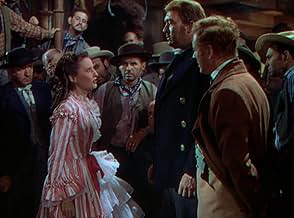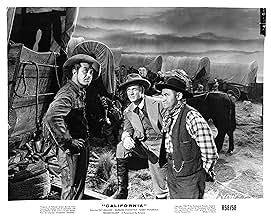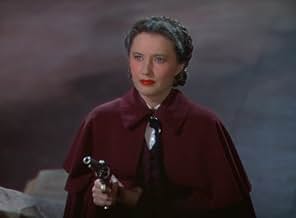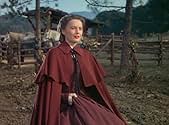CALIFICACIÓN DE IMDb
6.1/10
1.2 k
TU CALIFICACIÓN
Un desertor militar guía a Lily, Michael Fabian y otros colonos al Oeste hacia California durante la fiebre del oro, movidos por anhelos de aventura y riqueza.Un desertor militar guía a Lily, Michael Fabian y otros colonos al Oeste hacia California durante la fiebre del oro, movidos por anhelos de aventura y riqueza.Un desertor militar guía a Lily, Michael Fabian y otros colonos al Oeste hacia California durante la fiebre del oro, movidos por anhelos de aventura y riqueza.
- Dirección
- Guionistas
- Elenco
John Alban
- Delegate
- (sin créditos)
George Anderson
- Miner
- (sin créditos)
Carl Andre
- Wagon Train Member
- (sin créditos)
Billy Andrews
- Boy
- (sin créditos)
Opiniones destacadas
Epic account of how California became a state, featuring a wagon train full of settlers that joins Wicked" Lily Bishop (Barbara Stanwick) expeled from a town , to go California, led by Michael Fabian (Barry Fitzgerald) and Johnnny Trumbo (Ray Milland) . However , news of the Gold Rush scatters the caravan and subsequently taking on evil profiteers . But worse troubles are ahead : California is inching toward statehood and corrupt politicians wish other personal and mean purports .
Awesome epic Western with giant cast , gorgeous photography and wonderful scenarios . Turbulent and mighty story about an epic saga set against the background of Gold Rush and historical deeds ; covering several decades of Westward expansion in the nineteenth century--including the Gold Rush, and usual political confrontation . And of course , the building of the California State with certain politicians who want to make it their private empire ; among other epic events . The picture gets great action , expansive Western settings , shootouts , love stories , it is quite entertaining and there some some scenes still rate with the best of the West , including marvelous moments along the way . It efficiently describes an attractive panoramic view of the American Western focusing on the tribulations , trials and travels of settlers and adventurers . It's a big budget film with good actors , technicians, production values and pleasing results . Breathtakng as well as spectacular scenes such as the long Wagon Train , and the final attack sequences , among others . Particularly supreme for its all-star cast list with some actors epitomising the spirit of the early West , at least as Hollywood saw it , including the indomit wicked saloon queen Barbara Stanwick , the tough wagon train guide Ray Milland and his colleague the always sympathetic Barry Fitzgerald .And a splendid support cast as George Coulouris as the powerful storekeeper , former slaver Pharaoh Coffin , Albert Dekker , Anthony Quinn , Eduardo Ciannelli and Frank Faylen.
Impressive cinematography filmed in big screen by Ray Rennahan , and photographed in splendorous Technicolor , though it loses much of its overwhelming visual impact on TV but otherwise holds up pretty well . This star-studded, epic Western adventure is a really old style Hollywood film well directed by John Farrow . At his begining he stayed in Hollywood as a screenwriter, from A Sailor's Sweetheart (1927) through Tarzan escapes (1936). He married Tarzan's Jane, Maureen O'Sullivan, in 1936. He began directing in 1937 Men in Exile and West of Shanghai (1937). He was injured while serving as a Lieutenant Commander in the Royal Navy in World War II. After that he converted to Catholicism and wrote a biography of Thomas More, a history of the Papacy, a Tahitian/English dictionary and several novels. And directing notorious films as Wake island , This kind of woman , Hondo , Calcuta , China , The big clock , Red, Hot and Blue ,Alias Nick Beal , Beyond glory , Hitler Gang and several others . He collaborated in the writing of several of his films and shared the Academy Award for Around the world in 80 days (1956). Rating : 6.5/10 , essential and indispensable watching . It's a magnificent example of the kind of old-fashioned blockbuster just don't make anymore .
Awesome epic Western with giant cast , gorgeous photography and wonderful scenarios . Turbulent and mighty story about an epic saga set against the background of Gold Rush and historical deeds ; covering several decades of Westward expansion in the nineteenth century--including the Gold Rush, and usual political confrontation . And of course , the building of the California State with certain politicians who want to make it their private empire ; among other epic events . The picture gets great action , expansive Western settings , shootouts , love stories , it is quite entertaining and there some some scenes still rate with the best of the West , including marvelous moments along the way . It efficiently describes an attractive panoramic view of the American Western focusing on the tribulations , trials and travels of settlers and adventurers . It's a big budget film with good actors , technicians, production values and pleasing results . Breathtakng as well as spectacular scenes such as the long Wagon Train , and the final attack sequences , among others . Particularly supreme for its all-star cast list with some actors epitomising the spirit of the early West , at least as Hollywood saw it , including the indomit wicked saloon queen Barbara Stanwick , the tough wagon train guide Ray Milland and his colleague the always sympathetic Barry Fitzgerald .And a splendid support cast as George Coulouris as the powerful storekeeper , former slaver Pharaoh Coffin , Albert Dekker , Anthony Quinn , Eduardo Ciannelli and Frank Faylen.
Impressive cinematography filmed in big screen by Ray Rennahan , and photographed in splendorous Technicolor , though it loses much of its overwhelming visual impact on TV but otherwise holds up pretty well . This star-studded, epic Western adventure is a really old style Hollywood film well directed by John Farrow . At his begining he stayed in Hollywood as a screenwriter, from A Sailor's Sweetheart (1927) through Tarzan escapes (1936). He married Tarzan's Jane, Maureen O'Sullivan, in 1936. He began directing in 1937 Men in Exile and West of Shanghai (1937). He was injured while serving as a Lieutenant Commander in the Royal Navy in World War II. After that he converted to Catholicism and wrote a biography of Thomas More, a history of the Papacy, a Tahitian/English dictionary and several novels. And directing notorious films as Wake island , This kind of woman , Hondo , Calcuta , China , The big clock , Red, Hot and Blue ,Alias Nick Beal , Beyond glory , Hitler Gang and several others . He collaborated in the writing of several of his films and shared the Academy Award for Around the world in 80 days (1956). Rating : 6.5/10 , essential and indispensable watching . It's a magnificent example of the kind of old-fashioned blockbuster just don't make anymore .
In this movie John Farrow shows the great director he was. The camera work is exceptional, with scenes lasting more than 4 minutes filmed in just one take!. Although there are several of this scenes in the movie, there are other aspects to comment also. The actor's direction is superb, obtaining the most of all of them, in particular the performance of George Colouris (the villain) is outstanding. Moreover, this is not the typical western; the plot shifts unexpectedly from the line one assumes it will follow, to a very different one, and the movie maintains its coherence perfectly. A real gem.
Definitely NOT a great movie, but very enjoyable, especially if one is a Stanwyck fan. Cinematography bounced back and forth from lush, to "quick, get it done" shots.
Ray Milland did not quite cut it as the hardened trail boss and buffalo hunter. But maybe that's because his character really is not-he deserted from the army for getting involved with a married woman. Stanwyck shines as the self-reliant lady gambler and flirt who has been tossed around her whole life, with a few exceptions.
Yes the movie is rather corny, but let's face it the movie industry was right in the middle of the Macarthy era and needed safe material to work with. It DID give a rather honest perspective of how many lost sight of what they really had set out for, and how others took advantage, at any cost.
Ray Milland did not quite cut it as the hardened trail boss and buffalo hunter. But maybe that's because his character really is not-he deserted from the army for getting involved with a married woman. Stanwyck shines as the self-reliant lady gambler and flirt who has been tossed around her whole life, with a few exceptions.
Yes the movie is rather corny, but let's face it the movie industry was right in the middle of the Macarthy era and needed safe material to work with. It DID give a rather honest perspective of how many lost sight of what they really had set out for, and how others took advantage, at any cost.
This is a case where I feel like other reviewers have watched a different movie called "California" than the one I saw. The picture I enjoyed was a top-notch "A" western with an excellent cast, gorgeous Technicolor cinematography, spectacular California scenery, lively action, good pacing, and an intelligent, adult story.
At the top of the cast Ray Milland, Barbara Stanwyck, and Barry Fitzgerald, were at the peak of their careers. All three had garnered Academy Award honors within the past few years before "California's" early 1947 release. Milland was coming off his best actor award for Lost Weekend (1945), while Fitzgerald won best supporting actor for Going My Way (1944) and also got a best actor nomination for the same role! Stanwyck, a perennial bridesmaid of the Academy had received best actress nominations for Ball Of Fire (1941) and Double Indemnity (1944). "California" is a good showcase for their talents, each doing what he or she did best -- Ray the mild-mannered but hard-edged tough guy, Barry the lovable Irishman, and Barbara the hard broad who may or may not be hiding a heart of gold. Good support and stalwart villainy is provided by George Coulouris and Albert Dekker with a large cast of other supporting players and extras.
Some people can't picture Ray Milland as an appropriate western lead because of his British accent, even though it had became slight by the late 1940's when he had be living in the United States for two decades. But lots of people in the West would have had British and other foreign accents. Remember, we were and still are a nation of immigrants. Besides which Ray was imminently qualified to play westerns by his real life experiences. Having served several years in a crack British cavalry regiment in the 1920's, he was an expert horseman, and it shows by the way he sits a steed in "California". And he certainly knew which end of a gun the bullets came out of. A crack marksman, he helped his regiment win several prestigious shooting matches in his army days. Interestingly, he actually plays a professional trick shot artist in another western, Copper Canyon (see my review).
John Farrow's usual efficient direction and Eda Waren's editing keep the story moving along at a sharp pace. The script by Frank Butler and Theodore Strauss provides an intelligent, adult story with literate dialog. It gives an accurate, compelling picture of the California gold rush and the gold fever gripping immigrants to the Pacific Coast, as well as the movement for California statehood, a plot by the baddies for an armed overthrow of the government, and a torrid love triangle. As the intense, dark melodramas now known as film noir were at the height of their popularity when this western was filmed, the script endows the principles of the love triangle, Milland, Stanwyck, and Coulouris, with shady pasts. Milland's character, it turns out has deserted the Army. Stanwyck has been thrown out of every town she ever parked in for being -- shall we say charitably -- a floozy. Coulouris, villain enough as it is, has an even darker past as a slave ship captain. And he is now going slowly off his nut remembering the cries of the chained slaves and his fears they would rise up and get him. Dekker, occasionally a leading man or second lead, but more often a polished villain, is wasted here as Coulouris's former first mate and brutish henchman. Since Coulouris is always a bit over the top, perhaps "California" would have been better served if Dekker had had his role.
The script and Farrow's direction gives us just the right blend of dramatics and action. A rousing, old-time, full-bodied score by Victor Young helps move it along. Unlike other reviewers, I found the frequent outbursts of singing by both on-screen characters and an unseen chorus an asset to the picture, adding life and color and even historical accuracy. Some in this history challenged generation may not realize that in the days before people had television, computers, radio, movies, or even phonographs, they had to entertain themselves. They sang all the time, walking down the street, in their yards, in barber shops, at socials, around campfires (as in "California"), and in saloons. Even the meanest of saloons could usually scratch up some kind of band.
The costumes, sets, firearms, gun leather, lamps and other accouterments in "Callifornia" show an unusual degree of historical accuracy for a western of this era. No one has a repeating rifle, all muzzle loaders or crude breech loaders. Cap and ball revolvers are used in the closeups at least -- never mind they were not the exact models for 1849. You other gun nuts: in how many other movies have you seen a Hall breech loader? Good effort in this department.
Ray Rennahan, who did the camera work, gets credit for the unusually fine color cinematography, but with Natalie Kalmus on board as the Techniclor consultant, superb color was insured. The Technicolor Corporation required a consultant on every movie using their patented process, and Mrs. Kalmus, ex-wife of the inventor of Technicolor, was usually it. She was known around the studios as a bossy, irritating old dame, who interfered in set designs, camera set-ups, costume color and materials, prop selection, and virtually every other aspect of a color filming. She must, nevertheless, have known what she was doing. Every picture with her name on it will have muted, perfectly co-ordinated, precisely lighted, and generally superior color. After all, the studio technicians of the 1940's, as skilled as they were in black and white filming, had little experience with color. They actually needed a Natilie Kalmus, like it or not.
"California" in an A-1 Technicolor western, a visual treat and smooth, exciting entertainment from Hollywood's finest era.
At the top of the cast Ray Milland, Barbara Stanwyck, and Barry Fitzgerald, were at the peak of their careers. All three had garnered Academy Award honors within the past few years before "California's" early 1947 release. Milland was coming off his best actor award for Lost Weekend (1945), while Fitzgerald won best supporting actor for Going My Way (1944) and also got a best actor nomination for the same role! Stanwyck, a perennial bridesmaid of the Academy had received best actress nominations for Ball Of Fire (1941) and Double Indemnity (1944). "California" is a good showcase for their talents, each doing what he or she did best -- Ray the mild-mannered but hard-edged tough guy, Barry the lovable Irishman, and Barbara the hard broad who may or may not be hiding a heart of gold. Good support and stalwart villainy is provided by George Coulouris and Albert Dekker with a large cast of other supporting players and extras.
Some people can't picture Ray Milland as an appropriate western lead because of his British accent, even though it had became slight by the late 1940's when he had be living in the United States for two decades. But lots of people in the West would have had British and other foreign accents. Remember, we were and still are a nation of immigrants. Besides which Ray was imminently qualified to play westerns by his real life experiences. Having served several years in a crack British cavalry regiment in the 1920's, he was an expert horseman, and it shows by the way he sits a steed in "California". And he certainly knew which end of a gun the bullets came out of. A crack marksman, he helped his regiment win several prestigious shooting matches in his army days. Interestingly, he actually plays a professional trick shot artist in another western, Copper Canyon (see my review).
John Farrow's usual efficient direction and Eda Waren's editing keep the story moving along at a sharp pace. The script by Frank Butler and Theodore Strauss provides an intelligent, adult story with literate dialog. It gives an accurate, compelling picture of the California gold rush and the gold fever gripping immigrants to the Pacific Coast, as well as the movement for California statehood, a plot by the baddies for an armed overthrow of the government, and a torrid love triangle. As the intense, dark melodramas now known as film noir were at the height of their popularity when this western was filmed, the script endows the principles of the love triangle, Milland, Stanwyck, and Coulouris, with shady pasts. Milland's character, it turns out has deserted the Army. Stanwyck has been thrown out of every town she ever parked in for being -- shall we say charitably -- a floozy. Coulouris, villain enough as it is, has an even darker past as a slave ship captain. And he is now going slowly off his nut remembering the cries of the chained slaves and his fears they would rise up and get him. Dekker, occasionally a leading man or second lead, but more often a polished villain, is wasted here as Coulouris's former first mate and brutish henchman. Since Coulouris is always a bit over the top, perhaps "California" would have been better served if Dekker had had his role.
The script and Farrow's direction gives us just the right blend of dramatics and action. A rousing, old-time, full-bodied score by Victor Young helps move it along. Unlike other reviewers, I found the frequent outbursts of singing by both on-screen characters and an unseen chorus an asset to the picture, adding life and color and even historical accuracy. Some in this history challenged generation may not realize that in the days before people had television, computers, radio, movies, or even phonographs, they had to entertain themselves. They sang all the time, walking down the street, in their yards, in barber shops, at socials, around campfires (as in "California"), and in saloons. Even the meanest of saloons could usually scratch up some kind of band.
The costumes, sets, firearms, gun leather, lamps and other accouterments in "Callifornia" show an unusual degree of historical accuracy for a western of this era. No one has a repeating rifle, all muzzle loaders or crude breech loaders. Cap and ball revolvers are used in the closeups at least -- never mind they were not the exact models for 1849. You other gun nuts: in how many other movies have you seen a Hall breech loader? Good effort in this department.
Ray Rennahan, who did the camera work, gets credit for the unusually fine color cinematography, but with Natalie Kalmus on board as the Techniclor consultant, superb color was insured. The Technicolor Corporation required a consultant on every movie using their patented process, and Mrs. Kalmus, ex-wife of the inventor of Technicolor, was usually it. She was known around the studios as a bossy, irritating old dame, who interfered in set designs, camera set-ups, costume color and materials, prop selection, and virtually every other aspect of a color filming. She must, nevertheless, have known what she was doing. Every picture with her name on it will have muted, perfectly co-ordinated, precisely lighted, and generally superior color. After all, the studio technicians of the 1940's, as skilled as they were in black and white filming, had little experience with color. They actually needed a Natilie Kalmus, like it or not.
"California" in an A-1 Technicolor western, a visual treat and smooth, exciting entertainment from Hollywood's finest era.
I always thought Barbara Stanwyck had the measure of any of the men she co-starred with in westerns, and here she certainly holds her own as the manipulative "Lily". She joins a wagon train heading west, but the gold rush rumours split that up and so she proceeds to the coast where she quickly ends up owning quite a lucrative saloon. She's pretty much sharing control of the town with the odious storekeeper/daylight robbery merchant "Pharaoh Coffin" (George Colouris) when her erstwhile pals "Trumbo" (Ray Milland) and "Fabian" (Barry Fitzgerald) arrive, all amidst increasing calls for Californian statehood. Needless to say, those in power locally want the status quo - the new arrivals want something more "democratic". What now ensues are a series of cat-fights that keep this moving along well enough until, what I must admit to feeling was a bit of a disappointing denouement. Stanwyck stands out, and Fitzgerald and the rather oddly cast Coulouris are also effective. Milland, however, well he doesn't quite cut the mustard and there is way, way too much dialogue as this story takes far too long to get up any head of steam. Still, it's got a pioneering sort of spirit to it that I quite enjoyed.
¿Sabías que…?
- TriviaThis film was in production November 1945-February 1946, and bears a 1946 copyright statement, and was released in January 1947.
- ErroresA number of the pistols used by characters appear to be cartridge revolvers, rather than cap-and-ball.
- Citas
Lily Bishop: You may think you're pretty high and mighty, Trumbo. But let me tell you this... if I live long enough, and I will, I'm going to pull you down off that fancy horse of yours and shove your face in the muck - so help me!
- ConexionesFeatured in El poder del amor (1995)
Selecciones populares
Inicia sesión para calificar y agrega a la lista de videos para obtener recomendaciones personalizadas
- How long is California?Con tecnología de Alexa
Detalles
- Tiempo de ejecución1 hora 37 minutos
- Color
- Relación de aspecto
- 1.37 : 1
Contribuir a esta página
Sugiere una edición o agrega el contenido que falta



































